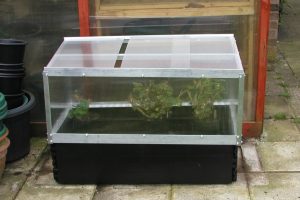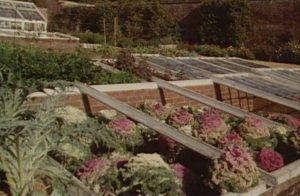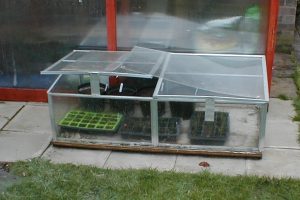Unlike a cloche that moves around the garden, being used for a relatively short period as plants establish or to extend the end of the season, the coldframe is more of a fixed permanent feature in the garden.
At one time nearly every gardener would have a coldframe. Those without a greenhouse would use their cold frame as a sort of mini-greenhouse and those who had a greenhouse would use their cold frame as an addition and intermediate step to planting out.
In recent years the popularity of coldframes seems to have declined yet they are as immensely useful today as they ever were.
Uses for a Cold Frame
The coldframe serves three main purposes:
- First it provides a sheltered and relatively warm environment to germinate seeds and bring seedlings on.
- Second, it provides a sheltered place to grow plants. If you do not have a greenhouse, you can grow cucumbers in a coldframe – hence the name frame cucumbers.
- Thirdly, the coldframe provides an intermediate stage between greenhouse and planting out in the great outdoors. This process is known as hardening off.
Hardening Off in the Coldframe
If you just take a plant from a nice warm greenhouse and stick it into the cold outside the shock may well kill it and will certainly check growth. The hardening off process introduces the plant to the outside gradually, enabling it to adapt and thrive in the outside world.
Take the plant from the greenhouse and place in the coldframe and open the lid for a few hours in the warmth of the afternoon. After a few days, leave the frame open all through the day, just closing it up at night or if it gets really cold.
By the end of a week to ten days you should be fine to leave the frame open day and night, just sheltering the plants from the worst of the cold. After a fortnight the plant can come out and go into the ground.

Raised Bed Coldframe
Excellent for hardening off etc. but also great for growing very early carrots and potatoes
Types of Cold Frame
There are a number of different types of coldframe.
Traditional Brick Built Coldframe
These were often attached to a greenhouse, coming off a dwarf walled side. They could be most any size from a size we would recognise today to quite large affairs which people could stand inside.
The large ones would often be used as hot beds, being filled with rotting manure and relying on the generated heat to bring on plants.
The Wooden Sided Cold Frame.
This is actually quite easy to build and well within the capabilities of the average person. The wooden sides help keep the warmth of the day in the house overnight and are quite robust. See How to Build a Coldframe
The Aluminium and Glass Cold Frame
This type of coldframe has the advantage of having glass sides, which allows more light to enter, avoiding drawing the plants and spindly stems. The drawback is that they do not hold the heat as well overnight as the wooden sided coldframe. With glass coldframes care should be taken if children are around, glass can be dangerous.
Twin Walled Plastic Cold Frames
Available with wooden or aluminium frames, these are glazed with twin walled polycarbonate. This does not allow as much light through as glass but is far better as an insulator than glass and not as fragile or dangerous if broken. Because the light is diffused by the material, the risk of scorching in sunny weather is reduced.
My experience with a thin wooden framed polycarbonate coldframe is that it warped allowing the glazing panels to spring free.
My Coldframes
I owned a wooden framed polycarbonate coldframe but as I mentioned the frame warped. I have a basic glass sided frame that is very good for hardening off although I have had to replace some panes due to accident. We’ve no little children running around but the cat leaping down from the fence managed to break the glass lights.
This is brilliant for growing very early potatoes and for carrots protecting them from the fly. The potatoes are planted shallowly in the base and this is then earthed up into the deep bed. When the weather warms up the foliage is up to the roof panels, these are removed and stored away. The sides provide enough protection for a shallow frost. Excellent really early crop of potatoes. You can see details of this cold frame in the allotment shop: Cold Frame & Raised Bed
Greenhouse Growing, Coldframes etc. Further information
- Best Position for a Greenhouse – Where to Site a Greenhouse
- Greenhouse Capillary Matting: A Comprehensive Overview
- Understanding Greenhouse Planning Permission: What You Need to Know
- Wooden Greenhouses Compared to Aluminium
- Greenhouse Heating Guide – Various Types Reviewed
- Second Hand Greenhouse – Buying, Dismantling and Re-building a Greenhouse
- Greenhouses in High Winds – Protect and Survive!
- Greenhouse Accessories for Heating and Ventilation
- Fitting out the Greenhouse: Shelving, Staging & Greenhouse Benches
- Watering the Greenhouse – Equipment to Help Greenhouse Watering
- Portable Greenhouses – Patio Greenhouses and Allotment Greenhouses
- Managing the Hobby Greenhouse
- Cold Frames – Uses of Coldframes – Types of Coldframe
- How to Build a Cold Frame for Free!
- An Indoor Greenhouse – The Dewpoint Propagating & Growing Cabinet
- Choosing a Greenhouse – What Greenhouse to Buy






